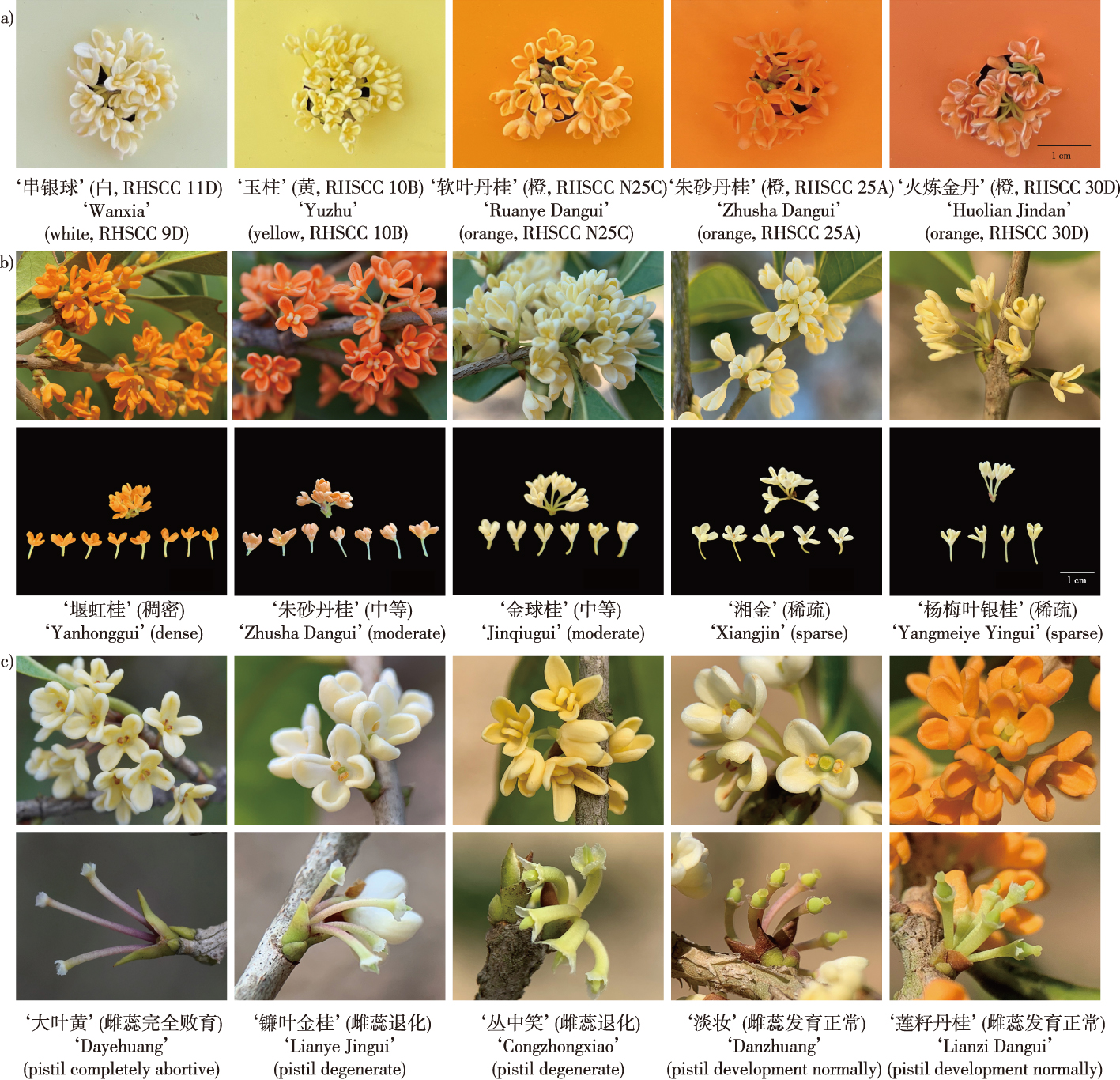 PDF(5559 KB)
PDF(5559 KB)


基于表型性状和SNP标记构建桂花主要品种资源的分子身份证
王一涵, 刘姣姣, 金沛权, 李书情, 魏建芬, 郭朋, 尚富德
南京林业大学学报(自然科学版) ›› 2024, Vol. 48 ›› Issue (4) : 12-24.
 PDF(5559 KB)
PDF(5559 KB)
 PDF(5559 KB)
PDF(5559 KB)
基于表型性状和SNP标记构建桂花主要品种资源的分子身份证
Construction of molecular ID for Osmanthus fragrans cultivars based on phenotypic traits and single nucleotide polymorphisms (SNPs)
【目的】筛选核心单核苷酸多态性(single nucleotide polymorphism,SNP)位点,建立基于KASP平台的桂花(Osmanthus fragrans)品种基因型快速检测方法,构建品种特异性分子身份证,为桂花品种鉴定、溯源、知识产权保护等提供理论基础。【方法】实地调查主流桂花栽培品种的重要表型特征。通过两轮严格筛选,从基因组SNP中保留一组能够完全鉴别测序品种的最优SNP标记,计算SNP 位点的多态信息含量(PIC)、期望杂合度(He)等信息。以‘日香桂’(‘Rixianggui’)基因组为参考,设计桂花特异性KASP引物并进行批量扩增,根据基因分型结果建立品种指纹图谱,评估核心SNP标记的品种鉴别力。结合品种表型信息码和品种分子指纹码构建桂花品种资源的分子身份证。【结果】筛选出14个能够完全鉴别测序品种的核心SNP位点。各位点PIC值的变化范围为0.246~0.375,平均值为0.335;He的变化范围为 0.288~0.500,平均值为0.431。针对核心位点设计的KASP引物基因分型准确。根据扩增结果构建DNA指纹图谱,可区分全部包括未测序品种在内的90个参试品种。对品种表型特征赋值,结合指纹码构建由34位数字组成的桂花品种资源分子身份证。【结论】确定了SNP1—SNP14共14个核心SNP位点,能够实现至少90个桂花品种的有效鉴别。结合品种群类型、表型特征和分子指纹码构建了90个桂花品种的唯一分子身份证,并生成对应的条形码和二维码。
【Objective】This study selected core genomic single-nucleotide polymorphism (SNP) loci to establish a rapid SNP genotyping method on the KASP platform, and to construct molecular IDs for Osmanthus fragrans cultivars. This study provides a theoretical foundation for identifying, tracing and protecting the intellectual property of O. fragrans cultivars.【Method】Field surveys were conducted to investigate key phenotypic characteristics of O. fragrans cultivars. Following two rounds of rigorous screening, we identified a set of core SNP markers capable of completely distinguishing previously sequenced cultivars. Subsequently, we analyzed the polymorphic information content (PIC) and expected heterozygosity (He) of each SNP locus. Using the genome sequences of ‘Rixianggui’ as a reference, species-specific KASP primers were designed for PCR amplification. Based on the genotyping results, we constructed cultivar DNA fingerprints and assessed the efficiency of core SNP markers for cultivar identification. Molecular IDs for O. fragrans cultivars were established by integrating phenotypic information codes with molecular fingerprint codes.【Result】We retained a total of 14 core SNP loci from genomic SNPs that fully discriminated the sequenced cultivars. The PIC values of these loci ranged from 0.246 to 0.375, with an average of 0.335, and the He indices ranged from 0.288 to 0.500, averaging 0.431. The KASP primers designed for these core SNP loci produced accurate genotyping results, enabling us to construct DNA fingerprints capable of distinguishing all 90 tested cultivars, including those not previously sequenced. Each cultivar was assigned a molecular ID composed of 34 digits.【Conclusion】In conclusion, 14 core SNP loci (SNP1 to SNP14) were identified that effectively discriminate among at least 90 O. fragrans cultivars. Unique molecular ID codes were constructed using DNA fingerprint codes along with serial codes derived from cultivar group types and phenotypic characteristics. Finally, barcode and quick response (QR) codes were generated for each cultivar.

桂花 / 品种鉴别 / 单核苷酸多态性 / 表型性状 / 分子身份证
Osmanthus fragrans / cultivar identification / single nucleotide polymorphism (SNP) / phenotype / molecular ID
| [1] |
赵宏波, 郝日明, 胡绍庆. 中国野生桂花的地理分布和种群特征[J]. 园艺学报, 2015, 42(9):1760-1770.
|
| [2] |
向其柏, 刘玉莲. 中国桂花品种图志[M]. 杭州: 浙江科学技术出版社, 2008.
|
| [3] |
杨康民. 中国桂花[M]. 北京: 中国林业出版社, 2013.
|
| [4] |
向民, 段一凡, 向其柏. 木犀属品种国际登录中心年报(1) 彩叶桂品种群的建立[J]. 南京林业大学学报(自然科学版), 2014, 38(1):2,187.
|
| [5] |
高丽, 何岳球, 孙志国, 等. 三个 “新发展” 下咸宁市中国桂花城传承创新发展研究[J]. 安徽农业科学, 2023, 51(12):256-259.
|
| [6] |
刘燕培, 李书情, 王长海, 等. 桂花新品种‘潢川丹桂’[J]. 园艺学报, 2022, 49(S2):229-230.
|
| [7] |
王良桂, 潘多, 丁卉芬, 等. 彩叶桂新品种‘南林彩云’[J]. 南京林业大学学报(自然科学版), 2023, 47(2):243-244.
|
| [8] |
国家质量监督检验检疫总局, 中国国家标准化管理委员会. 植物新品种特异性、一致性、稳定性测试指桂花:GB/T 24885—2010[S]. 北京: 中国标准出版社, 2011.
General Administration of Quality Supervision,Inspection and Quarantine of the People’s Republic of China, Standardization Administration of the People’s Republic of China. Guidelines for the conduct of test for distinctness,uniformity and stability-Sweet osmanthus(Osmanthus fragrans L.):GB/T 24885-2010[S]. Beijing: Standards Press of China, 2011.
|
| [9] |
UPOV. TGP/15. Guidance on the use of biochemical and molecular markers in the examination of distinctness,uniformity and stability(DUS). Geneva:UPOV, 2013.
|
| [10] |
李梅. 桂花种质资源遗传多样性研究及品种鉴定[D]. 南京: 南京农业大学, 2009.
|
| [11] |
邱帅, 吴光洪, 陈徐平, 等. 基于相关序列扩增多态性分子标记的桂花栽培品种演化分析[J]. 浙江大学学报(农业与生命科学版), 2017, 43(4):404-415.
|
| [12] |
乔中全, 王晓明, 李永欣, 等. 桂花优良品种‘珍珠彩桂’遗传多样性的ISSR分析及指纹图谱构建[J]. 湖南林业科技, 2016, 43(3):1-5.
|
| [13] |
罗仙英, 桂敬飞, 严治, 等. 贵州桂花种质资源遗传多样性的ISSR分析[J]. 种子, 2017, 36(6):62-66.
|
| [14] |
韩远记. 桂花品种资源遗传多样性的AFLP分析[D]. 开封: 河南大学, 2008.
|
| [15] |
|
| [16] |
|
| [17] |
|
| [18] |
李军, 董彬, 张超, 等. 桂花EST-SSR引物开发及在品种鉴定中的应用[J]. 浙江农林大学学报, 2018, 35(2):306-313.
|
| [19] |
|
| [20] |
|
| [21] |
|
| [22] |
魏中艳, 李慧慧, 李骏, 等. 应用SNP精准鉴定大豆种质及构建可扫描身份证[J]. 作物学报, 2018, 44(3):315-323.
|
| [23] |
|
| [24] |
|
| [25] |
|
| [26] |
贾清香. 基于RAD测序的野鸢尾和射干的SSR及SNP特征分析[D]. 沈阳: 沈阳农业大学, 2018.
|
| [27] |
|
| [28] |
|
| [29] |
|
| [30] |
|
| [31] |
|
| [32] |
NGUYENen,
|
| [33] |
|
| [34] |
|
| [35] |
|
| [36] |
|
| [37] |
李书情. 基于全基因组SNP的桂花品种精准鉴定体系的构建及应用[D]. 郑州: 河南农业大学, 2023.
|
| [38] |
|
| [39] |
|
| [40] |
|
| [41] |
|
| [42] |
路飞. 桂花新品种DUS测试指南的研制[D]. 南京: 南京林业大学, 2009.
|
| [43] |
|
| [44] |
臧德奎, 向其柏. 中国桂花品种分类研究[J]. 中国园林, 2004, 20(11):40-49.
|
| [45] |
尚富德, 陈仲芳, 刘玉莲, 等. 桂花品种资源调查方法研究[J]. 河南大学学报(自然科学版), 2003, 33(1):9-13.
|
| [46] |
|
| [47] |
|
| [48] |
李梓榕, 袁雄, 陈叶, 等. 基于全基因组SNP高效鉴定水稻种质资源并构建指纹图谱[J]. 分子植物育种, 2020, 18(18):6050-6057.
|
| [49] |
|
| [50] |
|
| [51] |
杨康民, 朱文江. 桂花[M]. 上海: 上海科学技术出版社, 1999.
|
| [52] |
任海龙, 许东林, 张晶, 等. 菜薹KASP-SNP指纹图谱构建及品种鉴定[J]. 园艺学报, 2023, 50(2):307-318.
|
| [53] |
王富强, 樊秀彩, 张颖, 等. SNP分子标记在作物品种鉴定中的应用和展望[J]. 植物遗传资源学报, 2020, 21(5):1308-1320.
|
| [54] |
|
| [55] |
樊晓静, 于文涛, 蔡春平, 等. 利用SNP标记构建茶树品种资源分子身份证[J]. 中国农业科学, 2021, 54(8):1751-1772.
|
| [56] |
赵仁欣, 李森业, 郭瑞星, 等. 利用SNP芯片构建我国冬油菜参试品种DNA指纹图谱[J]. 作物学报, 2018, 44(7):956-965.
|
| [57] |
朱国忠, 张芳, 付洁, 等. 适于陆地棉品种身份鉴定的SNP核心位点筛选与评价[J]. 作物学报, 2018, 44(11):1631-1639.
|
/
| 〈 |
|
〉 |